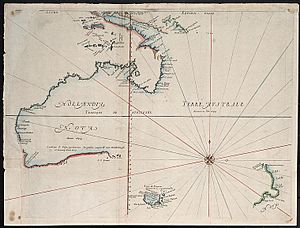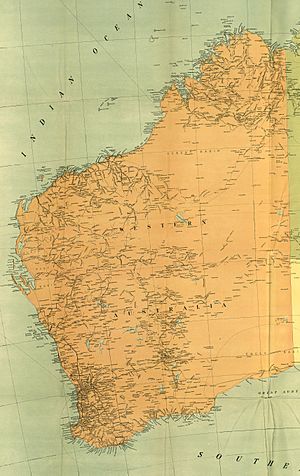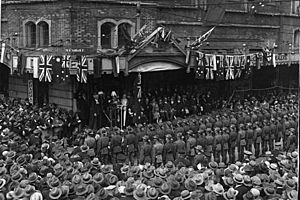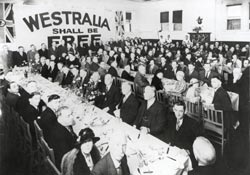History of Western Australia facts for kids
The human history of Western Australia began a very long time ago, between 40,000 and 60,000 years ago. This is when the first Indigenous Australians arrived on the northwest coast. From there, they spread across the rest of the continent.
The first time Europeans officially visited was in 1616. A Dutch explorer named Dirk Hartog landed on the west coast. He had been blown off course while sailing to Batavia, which is now called Jakarta.
Many European ships visited the coast over the next 200 years. However, no one tried to build a lasting settlement until December 1826. An expedition from the New South Wales government, led by Major Edmund Lockyer, landed at King George Sound. This place later became the city of Albany. On January 21, 1827, Lockyer officially claimed the western part of New Holland for the British Crown. This was the area west of the 129th meridian east. Soon after, the Swan River Colony was started in 1829. This colony eventually grew into the capital city we know today, Perth. Life was tough for the early settlers, so the population didn't grow much until gold was found in the 1880s. Since the gold rush, the number of people in the state has grown steadily, especially after World War II.
Western Australia gained the right to govern itself in 1890. Then, in 1901, it joined with five other states to form the Commonwealth of Australia. In 1933, many Western Australians wanted to separate from Australia and become fully self-governing again. They held a vote, and 68% of people supported leaving. However, in 1935, the British parliament said no. They explained that Australia's parliament would also need to agree. As the economy got better and the state received money from the federal government, the idea of leaving faded away.
Contents
First People: Aboriginal Settlement
When Australia's first people arrived on the northwest coast, the sea levels were much lower. This was between 40,000 and 60,000 years ago. The Kimberley coast was once only about 90 kilometers from Timor. Timor was the last in a chain of islands that humans could travel across. This means it was likely that Australia's first immigrants arrived here by simple boats. Other possible routes were through islands further north and then through New Guinea.
Over many thousands of years, these Indigenous Australians slowly moved south and east across the land. Aboriginal people were living all over Western Australia when European ships started arriving by accident in the early 17th century. These ships were usually on their way to Batavia (now Jakarta).
Early European Visits
The first European to see Western Australia was the Dutch explorer, Dirk Hartog. On October 26, 1616, he landed at a place now called Cape Inscription, on Dirk Hartog Island. Before he left, Hartog left a pewter plate attached to a post. This plate was later found, replaced, and then taken to the Rijksmuseum in Amsterdam.
The first English ship to visit was the Tryall in 1622. It was owned by the East India Company. The ship saw Point Cloates before it crashed on Tryal Rocks off the northwest coast. The crew stayed on the Montebello Islands for 7 days. They also saw Barrow Island before sailing to Batavia in a small boat. The Tryall is Australia's oldest known shipwreck.
Another English visitor was William Dampier, who sailed down the western coast of Australia in 1699. He noticed there wasn't much fresh water. He wrote about his frustration in his book "A Voyage to New Holland" when describing Shark Bay:
as the 7th of August when we came into Shark's Bay; in which we Anchored at three several Places, and stay'd at the first of them (on the W. side of the Bay) till the 11th. During which time we searched about, as I said, for fresh Water, digging Wells, but to no purpose.
Some parts of the Western Australian coastline were given names that didn't last. For example, Eendrachtsland. However, some names, like 't Landt van de Leeuwin (Leeuwin's Land), later became Cape Leeuwin.
Key European Discoveries and Explorations
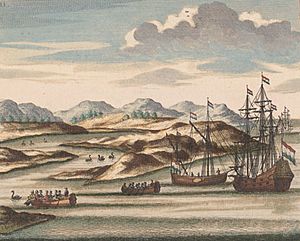
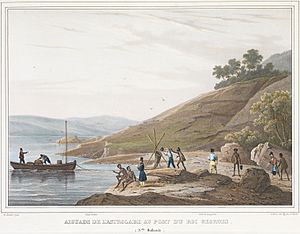
Here are some important events from Dirk Hartog's landing in 1616 until the Swan River Colony was settled in 1829:
- 1616 – Dirk Hartog arrived at Cape Inscription and left a pewter plate. This is believed to be the first time Europeans landed on Western Australian soil.
- 1618 – Willem Janszoon on the Mauritius landed on North West Cape. They saw footprints but didn't meet the local people.
- 1619 – Frederick de Houtman found dangerous shallow areas, which were named Houtman Abrolhos.
- 1622 – The English ship Tryall was wrecked off the northwest coast. Survivors sailed to Batavia in a small boat.
- 1629 – The Batavia hit a reef near the Abrolhos. The captain sailed for help. When he returned, he found that many survivors had been murdered by mutineers.
- 1656 – The Vergulde Draeck (Gilt Dragon) was shipwrecked near Ledge Point, north of the Swan River.
- 1697 – Willem de Vlamingh found Hartog's plate and left his own. He also explored the Swan River area.
- 1772 – Frenchman Louis Aleno de St Aloüarn landed at Turtle Bay on Dirk Hartog Island and claimed it for France.
- 1791 – George Vancouver formally claimed Possession Point at King George Sound, Albany.
- 1801 – French ships Geographe and Naturaliste explored much of the coast from Cape Leeuwin north, including the Swan River. They found de Vlamingh's plate.
- 1801 – Matthew Flinders saw Cape Leeuwin while mapping the southern Australian coastline.
- 1826 – A military group from New South Wales arrived at King George Sound.
- 1827 – Major Lockyer officially claimed the western part of Australia for Britain at King George Sound.
- 1829 – James Stirling explored the Swan River area. Captain Charles Fremantle again claimed the western side of New Holland for the British Crown on May 2.
Quick facts for kids
Swan River Colony (1829–1832)
Colony of Western Australia (1832–1901) |
|||||||||
|---|---|---|---|---|---|---|---|---|---|
| British Crown Colony | |||||||||
| 1829–1901 | |||||||||
| Government | |||||||||
| • Type | Self-governing colony | ||||||||
| Monarch | |||||||||
|
• 1829–1830
|
George IVfirst | ||||||||
|
• 1837–1901
|
Victoria last | ||||||||
| Governor | |||||||||
|
• 1829–1832
|
James Stirling first | ||||||||
|
• 1895–1900
|
Gerard Smith last | ||||||||
| History | |||||||||
| 1829 | |||||||||
| 1901 | |||||||||
|
|||||||||
The Colonial Era
King George Sound Settlement
The first official claim of land for Great Britain was made on September 29, 1791. Commander George Vancouver of the RN made this claim. He named the spot Possession Point, at Albany.
In the early 1800s, the British worried that France might try to start a colony on Australia's west coast. So, in 1826, the Governor of New South Wales, Ralph Darling, ordered a settlement to be built at King George's Sound. An army group was sent from Sydney. It was led by Major Edmund Lockyer and included soldiers, a doctor, a storekeeper, and convicts.
On January 21, 1827, all of Australia was finally claimed as British land. Major Lockyer officially took control of the western part of the continent at King George Sound.
In March 1831, the convict settlement was closed. Control of King George's Sound was moved from New South Wales to the Swan River Colony. Captain James Stirling decided that the settlement would be named "Albany" starting January 1, 1832.
Starting the Swan River Colony
The first major European settlements were started on the Swan River by James Stirling in 1829. The colonists first saw land on June 1. An official announcement was made on June 18, and the colony was formally started on August 12. As the Lieutenant Governor, Stirling had the power to make laws and manage daily life.
By 1859, all other Australian colonies had their own parliaments. People in Western Australia began to ask for the right to govern themselves too. The British Colonial Office didn't want this because the colony was growing slowly and still had convicts. Requests for elected members in the Legislative Council were sent to London in 1865 and 1869. In 1870, this was allowed. However, the Governor could still say no to the Council's decisions.
The main towns of the colony slowly grew into the port city of Fremantle and the main settlement, Perth. Perth was about 30 kilometers up the river.
Colony Growth: 1829–1850
Much of the land around the Swan River Colony wasn't good for farming. So, the colony had to expand beyond the Swan River area once the best spots were taken.
Sheep farming was the most successful early farming activity. It was the main reason for the colony's growth until the 1850s.
- 1829: A military outpost was built at Bunbury.
- 1830: The area around Augusta was settled.
- 1831: The first exploration over the Darling Range happened. This led to settling the Avon Valley and starting the town of York.
- 1832: The main settlement was officially named Perth. It was named after Sir George Murray's home in Perthshire, Scotland.
- 1833: The first newspaper, the Perth Gazette, was launched on January 5.
- 1833: Relations between Europeans and Aboriginal people were sometimes difficult. There were many small conflicts. Yagan, an important Aboriginal warrior, was killed on July 11.
- 1834: The Battle of Pinjarra happened on October 28. This was a very bad conflict.
- 1841: Explorer Edward John Eyre arrived in Albany after walking across the Nullarbor Plain from the eastern states.
- 1843: A count showed that Western Australia had 3,842 people.
- 1849: Gold was first found in the Jimperding-Toodyay area.
- 1850: After 19 years, the colony's growth was very slow. The population of the whole state was only 5,886. Most people lived around the southwestern coast in places like Bunbury, Augusta, and Albany.
The Convict Era
Western Australia started as a "free settlement," meaning no convicts. But money problems led settlers to ask for British convicts to be sent over. So, WA became a penal colony in 1850.
The Gregory brothers led important exploration trips to many parts of the colony:
- 1851: Augustus Gregory mapped the Greenough region near Geraldton. This area then opened up for farming.
- 1861: Francis Gregory explored the inner part of the Nickol Bay region, later known as the Pilbara.
By 1859, other Australian colonies had their own parliaments. Western Australian colonists started asking for the right to govern themselves. The British Colonial Office said no because the colony was growing slowly and still had convicts. Requests for elected members in the Legislative Council were sent to London twice in the 1860s.
By 1868, over 9,000 convicts had been sent to Western Australia on 43 convict ships.
Colony Growth: 1861–1885
Wool production, usually on large sheep farms, also helped the colony expand further east and north.
The first lasting settlements in the North West (later called the Pilbara and Kimberley regions) began in the mid-1860s. These were first at the Harding River, De Grey River, and Roebourne. Pearling also became very important in the North West. Unlike southern WA, Aboriginal Australians often did the hard labor in the North West.
In 1870, some members of the Legislative Council were elected for the first time. However, only male settlers with a lot of property could vote. The Governor could still stop the Council's decisions.
John Forrest led two major expeditions:
- 1870 – He followed Edward John Eyre's land route from Perth to Adelaide. This was to plan a telegraph line.
- 1874 – He led a group to the Murchison River and then east into the Central Desert.
In the 1870s, the Murchison and Gascoyne regions were also settled by Europeans.
- 1877: The telegraph line from Adelaide to Perth was finished. This greatly improved communication across Australia.
- 1883: The Durack family settled around the Ord River in the East Kimberley.
Gold Discoveries: 1885–1900
Until the 1880s, Western Australia's economy mainly relied on wool and wheat. A big change happened in 1885 when gold was found. Tens of thousands of prospectors rushed across the land, hoping to find new goldfields.
In 1887, a new plan for self-government was created and sent to London for approval. People argued that because of the new wealth from gold, Western Australia should be able to govern itself. The British Parliament passed a law in 1890 that gave the Colony independence. This meant it could make its own decisions, except for foreign policy, defense, and "native affairs."
Section 70 of this law created an Aboriginal Protection Board, controlled by the British Parliament, not Western Australia's. Governor Broome had warned the British that Western Australians couldn't be trusted with Aboriginal matters. Another part of the constitution said that money should be set aside for Aboriginal people's welfare. Many settlers didn't like these rules, and Western Australia has never fully followed this part of its own constitution.
In 1891, the rush to the Murchison goldfields began when Tom Cue found gold at the town now named after him. Many gold towns grew quickly, like Day Dawn and Kalgoorlie. But they were often abandoned when the gold ran out.
More miners came from other Australian colonies and overseas. This led to more trade unions in Western Australia. The Trades and Labor Council, Perth was started in 1891.
John Forrest, the first Premier of Western Australia, disagreed with the Governor about Section 70. By 1892, he was trying to change it.
Discoveries at Coolgardie (1892) and Paddy Hannan's discovery at Kalgoorlie (1893) truly started the gold fever.
Gold also led to new explorations. In 1896, David Carnegie led a big trip through the deserts north of Coolgardie to Halls Creek in the Kimberley.
In the late 1800s, there was talk of the gold-rich area around Kalgoorlie separating from Western Australia. They wanted to form a new state called "Auralia." This happened at the same time Perth was unsure about joining the Australian federation.
In 1899, Forrest successfully passed a law that took control of Aboriginal Affairs away from the British Parliament. Many Aboriginal people argue that this change was illegal. They believe that money should still be set aside for Aboriginal welfare, as originally planned.
- 1887: A cyclone hit the pearling fleet near Broome, killing 140 people.
- 1889: The Great Southern Railway opened, helping the economy grow along the line.
- 1895: Kings Park officially opened on August 10.
- 1897: Fremantle Inner Harbour officially opened after being built under the direction of C. Y. O'Connor.
Western Australia as a State of Australia
On January 1, 1901, Queen Victoria announced the creation of the Commonwealth of Australia. Western Australia, along with five other British colonies, joined to form the federation. They each became states. Western Australia was a bit slow to join. It only agreed after being promised a railway line connecting the west coast to the east coast.
Development in the Early 20th Century
The wealth from gold soon faded. By the early 1900s, the economy again relied on wool and wheat. This meant that when wool and wheat prices dropped sharply in the late 1920s and early 1930s, the state's economy collapsed. It didn't recover until after World War II. After the war, the government's immigration policy brought many new people, mostly from Europe, between 1947 and 1970.
Important events in Western Australia during this time:
- 1902: The Premier, George Leake, died suddenly at age 45. He is the only Western Australian Premier to die while in office.
- 1911: The University of Western Australia opened. It was the first university in Western Australia.
- 1912: A cyclone hit the coast near Port Hedland. It caused the loss of the ship Koombana and over 150 lives. This was Australia's worst weather-related sea disaster of the 20th century.
- 1917: The transcontinental railway was finished. This fulfilled a promise made when Western Australia joined the Federation in 1901.
- 1920: Western Australia passed a law allowing women to run for parliament. Edith Cowan was elected, becoming the first woman elected to any Australian parliament.
- 1929: Western Australia celebrated its Centenary (100 years).
- 1930: Perth was connected to Adelaide and the eastern states by a telephone line.
- 1933: In a vote, 68% of people wanted Western Australia to leave the Commonwealth. The Premier, Philip Collier, argued for this in London, but the British said they couldn't allow it.
- 1935: A cyclone hit the Lacepede Islands near Broome. It sank 21 pearling boats and killed 141 people. This was Australia's second deadliest cyclone in the 20th century.
World War II Impact
- 1941: A battle happened between HMAS Sydney and the German ship Kormoran off the coast near Carnarvon. Both ships sank, and all 645 crew members on Sydney were lost.
- 1942: Japanese planes attacked Broome. 88 people died. Other towns like Wyndham and Port Hedland also suffered attacks.
Major Events Since 1945
- 1946: Over 800 Aboriginal workers took part in the 1946 Pilbara strike. This was the first major strike by Indigenous Australians.
- 1947: Western Australia joined Australia's domestic cricket competition, the Sheffield Shield. They won the shield in their first season.
- 1952: On October 3, the first nuclear bomb was exploded on Australian soil at the Montebello Islands. This was part of Britain's first nuclear weapon test.
- 1961: Western Australia's worst bushfires destroyed many small communities, including 132 houses in Dwellingup. No one died, but 800 people lost their homes.
- 1961: A minerals boom began when the ban on iron ore exports was lifted. The economy grew a lot over the next 20 years because of nickel mines near Kalgoorlie and iron ore mines in the north-west.
- 1964: On December 31, Donald Campbell broke the world water speed record in his Bluebird K7 on Lake Dumbleyung. He reached 442 km/h.
- 1967: Aboriginal people were recognized as Australian citizens and gained the right to vote.
- 1968: The 1968 Meckering earthquake happened.
- 1970: The Indian Pacific train completed its first journey by rail across the continent from Sydney to Perth.
- 1979: The NASA space station Skylab crashed in the remote southeastern part of the state. Places like Rawlinna and Balladonia gained international attention.
- 1983: The start of WA Inc. Government deals with private business people led to the loss of $600 million in public money.
- 1993: The Perth-Joondalup railway line was completed, extending train transport to Perth's northern suburbs.
- 2007: The Perth-Mandurah railway line was completed.
Images for kids


